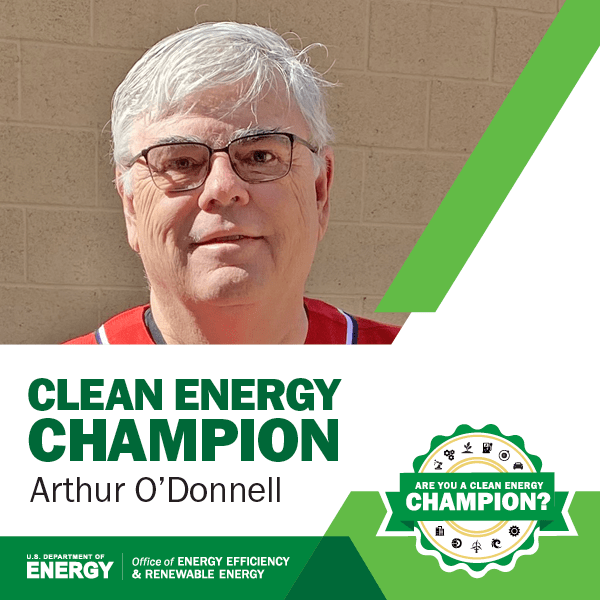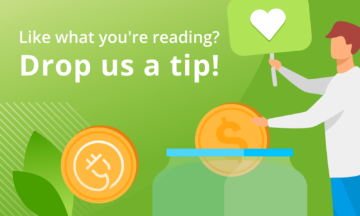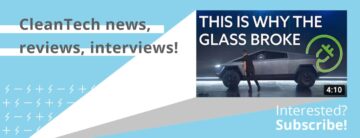Sign up for daily news updates from CleanTechnica on email. Or follow us on Google News!
When Arthur O’Donnell was in college studying communications, he wanted to work in media. What he didn’t know was that his journalism career would lead him to become a champion for New Mexico’s energy transition.
Meandering paths to clean energy careers are not uncommon, and the industry benefits greatly from the diversity of backgrounds and skills it attracts. That’s why the U.S. Department of Energy (DOE) creates and supports programs that open doors for students, recent grads and established professionals seeking energy jobs. The Clean Energy Innovator Fellowship (CEIF) is one of these programs, funding Fellows to spend up to two years supporting clean energy projects at critical energy organizations.
O’Donnell arrived at the New Mexico Public Regulation Commission (NM PRC) as a Fellow in 2020. After completing his two-year fellowship, he was hired as the Director of Policy Administration to help develop innovative ways to integrate solar power and distributed energy resources with the state’s electric grid. O’Donnell now mentors a CEIF Fellow himself at NM PRC, passing down the opportunities and learnings he gained.
“What I find most exciting is energizing people around change,” O’Donnell said. “Having younger staff at long-standing energy institutions is helpful. They see what can be accomplished, and they’re motivated to contribute to progress in the areas they care about.”
In this interview, O’Donnell reflects on his career, the value of mentorship, and why now is the time to take advantage of unprecedented Federal funding and resources aimed at clean energy jobs.
What was your previous experience with clean energy work prior to the fellowship?
Looking back, diversification of the energy mix has always been a part of my jobs. My interest was sparked when I became a radio news reporter in the 1970s and covered Washington state’s plans to build five nuclear power plants. By the 80’s, I was covering the infancy of renewable energy regularly. I loved being close to this zeitgeist of change, and my career as an energy journalist continued for the next 20 years. The expertise I developed while reporting ultimately landed me a job with the California Public Utilities Commission as a lead analyst, where I helped implement a piece of legislation to get utilities to plan and procure energy storage.
What project(s) did you support during your fellowship?
I did many things focused on rulemaking and implementing policies and programs around grid modernization. My emphasis on stakeholder engagement and alignment helped ensure that the rules had broad support and introduced new participants into the regulatory process. I’ve supported the launch of a 200 MW Community Solar program, substantial updates to utility interconnection rules, and the state requirement for advanced inverter installation. I’m proud to say that New Mexico’s interconnection policy is now a model for other states.

What did you find most valuable about the experience?
It’s challenging for people with non-traditional backgrounds like mine to break into energy policy work; there’s a long line of highly qualified professionals competing for these jobs. The fellowship opened the door to the energy community in New Mexico, where I had just moved. The commissioners needed expert advisory assistance to focus on these types of grid modernization initiatives. My outsider’s perspective allowed me to recommend creative solutions. When change in the commission came, my current position was created, and I was able to continue the work I started.
What advice would you give future fellows?
Mostly, I want them to see this as a tremendous opportunity. The fellowship is so educational, and it helps you figure out if this is the career path you want to take. Take advantage of the federal funding and resources designed to provide capacity to states that really need them. Also, use the professional development stipend to advance your skills and expertise. You get $10,000. Spend it wisely, because this may be the only time in your career that you’ll have such a flexible resource.
Interested in participating in Clean Energy Innovator Fellowship? Learn more.
To fully transition to clean energy, we need champions at every level. Whether you want to work in clean energy, invest in clean energy or energy-efficient upgrades for your home, apply for EERE opportunities, or simply learn more about the benefit of clean energy, YOU can be a Clean Energy Champion. The revolution is now. Join us.
Courtesy of Department of Energy.
Have a tip for CleanTechnica? Want to advertise? Want to suggest a guest for our CleanTech Talk podcast? Contact us here.
Latest CleanTechnica TV Video
[embedded content]
I don’t like paywalls. You don’t like paywalls. Who likes paywalls? Here at CleanTechnica, we implemented a limited paywall for a while, but it always felt wrong — and it was always tough to decide what we should put behind there. In theory, your most exclusive and best content goes behind a paywall. But then fewer people read it!! So, we’ve decided to completely nix paywalls here at CleanTechnica. But…
Thank you!
Advertisement
CleanTechnica uses affiliate links. See our policy here.
- SEO Powered Content & PR Distribution. Get Amplified Today.
- PlatoData.Network Vertical Generative Ai. Empower Yourself. Access Here.
- PlatoAiStream. Web3 Intelligence. Knowledge Amplified. Access Here.
- PlatoESG. Carbon, CleanTech, Energy, Environment, Solar, Waste Management. Access Here.
- PlatoHealth. Biotech and Clinical Trials Intelligence. Access Here.
- Source: https://cleantechnica.com/2024/02/22/meet-the-champion-who-helped-new-mexicos-clean-energy-transition-through-fellowship/
- :has
- :is
- :not
- :where
- $UP
- 000
- 15%
- 20
- 20 years
- 200
- 2020
- 36
- a
- Able
- About
- accomplished
- administration
- advance
- advanced
- ADvantage
- Advertise
- advice
- advisory
- Affiliate
- After
- aimed
- alignment
- allowed
- also
- always
- an
- analyst
- and
- Apply
- ARE
- areas
- around
- arrived
- Arthur
- AS
- Assistance
- At
- Attracts
- back
- backgrounds
- BE
- became
- because
- become
- been
- behind
- being
- benefits
- BEST
- Bit
- Break
- broad
- build
- but
- by
- california
- came
- CAN
- Capacity
- care
- Career
- careers
- challenging
- champion
- Champions
- change
- chip
- clean
- clean energy
- cleantech
- Cleantech Talk
- Close
- College
- commission
- Communications
- community
- Companies
- competing
- completely
- completing
- content
- continue
- continued
- contribute
- covered
- covering
- created
- creates
- Creative
- critical
- Current
- decide
- decided
- Department
- Department of Energy
- Department Of Energy (DOE)
- designed
- develop
- developed
- Development
- DID
- Director
- distributed
- diversification
- Diversity
- DOE
- don
- Door
- doors
- down
- during
- educational
- Electric
- embedded
- emphasis
- energy
- energy projects
- engagement
- ensure
- established
- Every
- exciting
- Exclusive
- experience
- expert
- expertise
- facts
- Federal
- fellow
- fellows
- felt
- fewer
- Figure
- Find
- five
- flexible
- Focus
- focused
- For
- from
- fully
- funding
- funding opportunities
- future
- gained
- get
- Give
- Goes
- greatly
- Grid
- Guest
- had
- Have
- he
- help
- helped
- helpful
- helps
- here
- highly
- him
- himself
- his
- HTTPS
- i
- if
- implement
- implemented
- implementing
- in
- industry
- initiatives
- innovative
- Innovator
- installation
- institutions
- integrate
- interconnection
- interest
- Interview
- into
- introduced
- Invest
- IT
- Job
- Jobs
- join
- Join us
- journalism
- journalist
- just
- Know
- launch
- lead
- LEARN
- Legislation
- Level
- like
- likes
- Limited
- Line
- links
- Long
- long-standing
- loved
- many
- max-width
- May..
- me
- Media
- Meet
- mentors
- Mentorship
- Mexico
- mine
- mix
- model
- modernization
- more
- most
- motivated
- moved
- my
- Need
- needed
- New
- news
- next
- node
- now
- nuclear
- Nuclear power
- of
- on
- ONE
- only
- open
- opened
- opportunities
- Opportunity
- or
- organizations
- Other
- our
- out
- part
- participants
- participating
- Passing
- path
- paths
- People
- perspective
- piece
- plan
- plans
- plants
- plato
- Plato Data Intelligence
- PlatoData
- player
- podcast
- policies
- policy
- position
- power
- power plants
- PRC
- previous
- Prior
- process
- procure
- professional
- professionals
- Program
- Programs
- Progress
- projects
- proud
- provide
- public
- publish
- put
- qualified
- Radio
- Read
- Reader
- really
- recent
- recommend
- reflects
- regularly
- Regulation
- regulatory
- Renewable
- renewable energy
- reporter
- Reporting
- requirement
- resource
- Resources
- Revolution
- rules
- s
- Said
- say
- see
- seeking
- should
- skills
- So
- solar
- Solar Power
- Solutions
- sparked
- spend
- Staff
- stakeholder
- started
- State
- States
- storage
- Stories
- Students
- Studying
- substantial
- such
- suggest
- support
- Supported
- Supporting
- Supports
- T
- Take
- Talk
- team
- that
- The
- The State
- Them
- then
- theory
- There.
- These
- they
- things
- this
- Through
- time
- tip
- to
- tough
- transition
- tremendous
- tv
- two
- types
- u.s.
- Ultimately
- Uncommon
- unprecedented
- Updates
- upgrades
- us
- use
- uses
- utilities
- utility
- Valuable
- value
- Ve
- Video
- want
- wanted
- was
- washington
- ways
- we
- What
- when
- whether
- while
- WHO
- why
- wisely
- with
- Work
- would
- write
- Wrong
- years
- you
- Younger
- Your
- youtube
- zeitgeist
- zephyrnet






